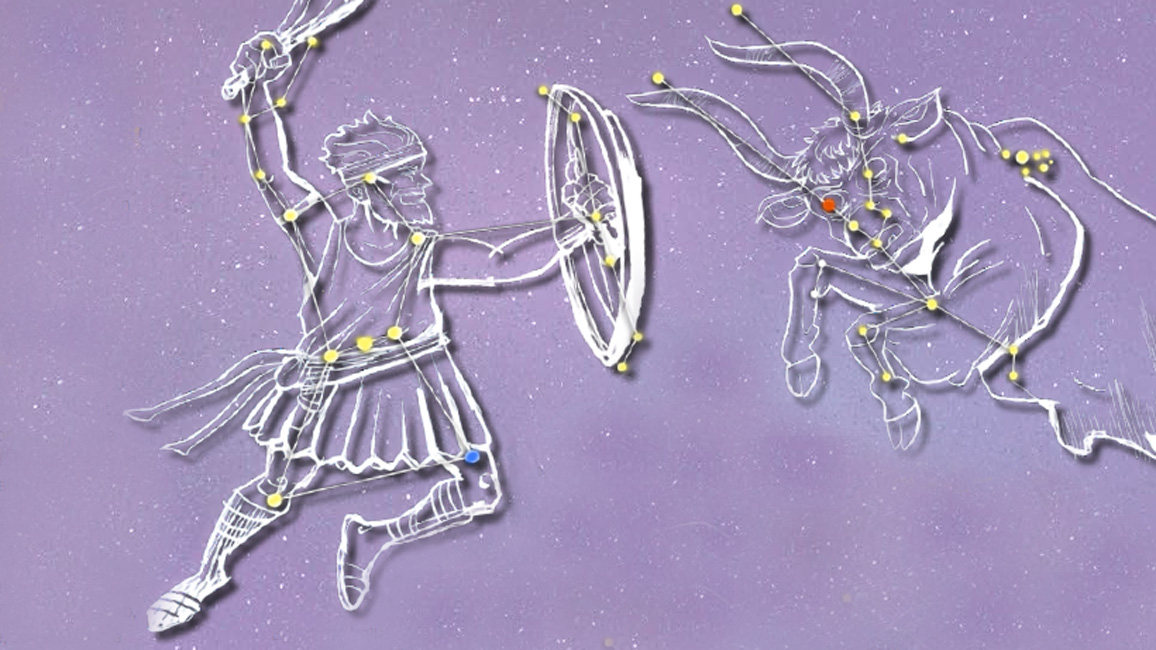
Gaze into the sky on a clear winter’s night, and you can’t miss it: the great hunter, Orion!
by Mary Algozin; art by Jamar Nicholas
In ancient times, people used the starry night sky as a calendar. They could do this because the stars show up in different parts of the sky at different times of the year. Once you know which star is which, you can tell what time of year it is.
By looking at the night sky, people long ago knew when to prepare for festivals, when to plant crops, and when to watch for floods. The ancient Egyptians, for instance, knew when the Nile River would overflow its banks each year. How? It usually happened when a bright star called Sirius (SEER-ee-us) rose in the sky just before daybreak.
Sky Patterns
People noticed that certain groups of stars seemed to form shapes in the night sky. Some shapes reminded them of gods and goddesses or heroes and mythical beasts. These starry patterns are called constellations (kon-stuh-LAY-shunz). There are many stories told about the constellations. The stories were important because they helped people tell the stars apart. By listening to the stories, people also could learn about their own histories and religions.
One very bright constellation was familiar to people all over the world. We know it as Orion (or-RYE-un).
Who Are You Really, Orion?
Orion was different things to different people. The ancient Greeks and Romans gave the constellation that name. To them Orion was a handsome man, the greatest hunter in the world.
According to one story, Orion fell in love with Artemis (AR-tuhmiss), the Greek goddess of hunting. But Artemis’s brother, Apollo, didn’t approve, so he played a cruel trick. He saw Orion one day, way off in the distance. He dared Artemis to prove her expert aim by shooting at the faraway figure. Her arrow struck and killed the hunter. When she found out what she had done, she was very sad. She placed Orion among the stars in the night sky so he’d be remembered forever.
People in other parts of the world told different tales about this constellation. They also gave it different names.
For example, the ancient Egyptians believed it was Osiris (oh-SYE-riss), their god of the dead. To one group of American Indians, it was Long Sash, a hero who led the tribe on a dangerous journey. The Chinese called it Tsan, the commander of a mighty army.
See for Yourself!
From November through February in the United States, Orion is easy to spot at night. Tonight, go outside around 9:00 p.m. and look in the eastern part of the sky. Search up from the horizon until you see three bright stars in a row. They make up Orion’s belt.
Above the belt are two brighter stars—the hunter’s shoulders. And below the belt are two other bright stars—his knees. Want to find out what Orion is up to? Trace an imaginary line from his belt up and to the right. You’ll come to a bright star with a slightly red color. That’s Aldebaran (al-DEB-uh-run), the eye of a bull named Taurus (TAWR-us), another constellation.
In one arm, Orion holds a shield for protection. In the other, he carries a club as a weapon against the giant bull. Why? He’s trying to save seven sisters that Taurus has kidnapped. The sisters make up a cluster of stars called the Pleiades (PLEE-uhdeez). You can find them near Taurus’s shoulder, to the right of Aldebaran.
More Starry Stories?
Bet you never knew so much exciting stuff was going on every night, high up in the sky. Take another look. Do you notice any other bright stars that form patterns?
Here’s an idea: Find out more about constellations at your local planetarium or library or on the Internet. Then make up some of your own wild tales about the patterns you see in the night sky. Send your favorite tale, along with a drawing of your constellation, to
Ranger Rick
11100 Wildlife Center Drive
Reston, VA 20190-5362
email: rick@nwf.org
Rangers: In many places, city lights brighten the night sky, making it hard to see stars. If you can, try to find a place where this light pollution isn’t so bad. Also, pick a clear night when the moon isn’t so full and bright. —R.R.
“Hunter in the Sky” appeared in the November 2018 issue of Ranger Rick magazine.
Click here to see the full article.

